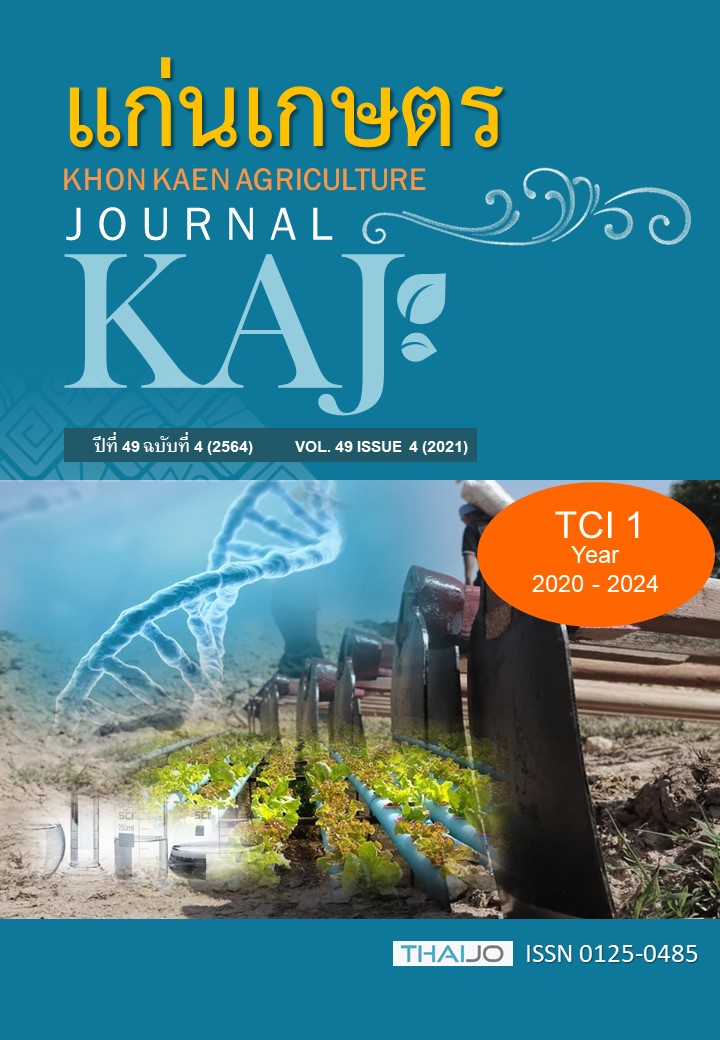Association between growth traits and flooding tolerance of sugarcane genotypes
Main Article Content
Abstract
Some growth traits during flooding might be a promising criterion for selection for flooding tolerance in sugarcane. The objectives of this study were to evaluate the effect of flooding in tillering stage on growth and investigate the relationships between flooding tolerance and growth traits of sugarcane. Five sugarcane genotypes were examined for comparison between control and flooding condition in tillering stage. Data were collected on growth traits and total dry weight after prolonged flooding. Flooding reduced number of tillers, stalk diameter, number of leaves, leaf area and total dry weight. However, there were no flooding effect to stalk height and number of nodes. Genotype differences were observed for flooding tolerance. KPS 01-4-29 showed the highest of flooding tolerance because it had the highest of total dry weight under flooding condition and flooding tolerance index. The correlation coefficients between total dry weight and number of tillers, stalk diameter, stalk height, number of nodes, number of leaves and leaf area were positive and significant (r = 0.54* to 0.92**). Moreover, tolerance index of total dry weight was also correlated positively with tolerance index of stalk diameter, stalk height, number of nodes, number of leaves and leaf area (r = 0.52* to 0.86**). Therefore, these traits could be used as selection criteria in selecting genotypes for flooding tolerance in sugarcane.
Article Details

This work is licensed under a Creative Commons Attribution-NonCommercial-NoDerivatives 4.0 International License.
References
จิราพร บำรุงไร่, อรุณี พรมคำบุตร และอนันต์ พลธานี. 2557. ปัญหาและข้อจำกัดในการปลูกอ้อยในนาพื้นที่ราบน้ำท่วมถึงและพื้นที่ลูกคลื่นลอนตื้น ตำบลดอนหัน อำเภอเมือง จังหวัดขอนแก่น. แก่นเกษตร. 42: 208-217.
สถาบันวิจัยพืชไร่และพืชทดแทนพลังงาน. 2552. เอกสารแนะนำ คู่มือการปลูกอ้อย. สถาบันวิจัยพืชไร่และน้ำตาล กรมวิชาการเกษตร.
สำนักงานคณะกรรมการอ้อยและน้ำตาลทราย. 2561. รายงานพื้นที่ปลูกอ้อย ปีการผลิต 2560/61. กลุ่มเทคโนโลยีสารสนเทศและการสื่อสาร กองยุทธศาสตร์และแผนงาน. สำนักงานคณะกรรมการอ้อยและน้ำตาลทราย.
สำนักงานคณะกรรมการอ้อยและน้ำตาลทราย. 2562. รายงานพื้นที่ปลูกอ้อย ปีการผลิต 2561/62. กลุ่มเทคโนโลยีสารสนเทศและการสื่อสาร กองยุทธศาสตร์และแผนงาน. สำนักงานคณะกรรมการอ้อยและน้ำตาลทราย.
Glaz, B. and S.E. Lingle. 2012. Flood duration and time of flood onset effects on recently planted sugarcane. Agronomy Journal. 104: 575-583.
Gomathi, R., P. N. Gururaja Rao, K. Chandran, and A. Selvi. 2015. Adaptive responses of sugarcane to waterlogging stress: An over view. Sugar Tech. 17: 325-338.
Jain, R., A. Singh, S. Singh, P. Surendra, V. Kumar Srivastava, A. Chandra, A. Dutt Pathak, and S. Solomon. 2017. Physio-Biochemical characterization of sugarcane genotypes for waterlogging tolerance. World Journal of Agricultural Sciences. 13: 90-97.
Jaiphong, T., J. Tominaga, K. Watanabe, R. Suwa, M. Ueno, and Y. Kawamitsu. 2017. Change in photosynthesis, growth, and sugar content of commercial sugarcane cultivar and Erianthus under flood conditions. Plant Production Science. 20: 126-135.
Sanghera, G. S., and N. S. Jamwal. 2019. Perspective for genetic amelioration of sugarcane towards water logged conditions. International Journal of Pure and Applied Bioscience. 7: 484-502.
Singh, S., S.P. Singh, A.D. Pathak, and N. Pandey. 2019. Assessment of waterlogging induced physio-biochemical changes in sugarcane varieties and its association with waterlogging tolerance. Journal of Environmental Biology. 40: 384-392.
Tavares, A. C. S., S. N. Duarte, N. S. Dias, F. V. Silva Sá, J. H. Miranda, K. T. S. Souza, M. A. M. Pizani, O. N. S. Neto, and C. S. Fernandes. 2018. Growth of sugar cane under cultivation flooded at different speeds lowering of the water table. Journal of Agricultural Science. 10: 122–131.


